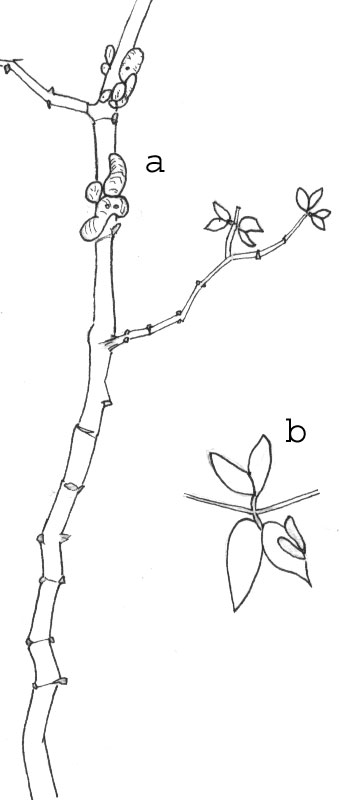Creosote Bush
Larrea tridentata

Sketch of a creosote bush twig observed at Courthouse Rock in the Eagletail Mts., La Paz Co., April 1992. (a) Oblong blobs of lac on the stems created by secretions of the Creosote Bush Lac Scale, Tachardiella larreae; (b) A pair of opposite, compound leaves host to blister-like galls caused by larvae of gall midges, Asphondylia.
Among the more usefull insects in the Sonoran Desert is a lac scale found on creosote bush. Like the lac scale (Laccifer lacca) from which commercial shellac is obtained, this immobile, plant sucking bug coats itself in a secretion of long chain hydrocarbons derived from excess sugars in the plant sap it consumes. Native Americans living in the Southwestern Deserts discovered that this insect's shell covering could be used as an adhesive. Upon gentle heating the lac liquifies and can be used like glue. For the insects the lac serves to protect them from the elements and some predators. Euler and Jones, 1956, reported an archeological find suggesting that this lac was also used to hermetically seal food inside a pottery jar.
These lumps on the twigs of creosote bush do not look much like insects at all. No legs, wings or other body parts are visible. The insects are completely covered by an orange-brown shell of lac. Minute wasp parasites are not detered by the hard lac coating, but may be partially detered by ants. Active scale insect colonies are usually attended by ants which gather honey dew and defend the scales against attack.
Zygophyllaceae -- Caltrop Family
Sponsored Links:
More Info:
- Creosote Bush: Page 1, Page 2, and Page 3
- Google Images - Creosote Lac Scale
- Google Scholar Literature Search - Creosote Lac Scale
The leaf galls shown in the illustration are caused by gall midges, Asphondylia, very similar to the midges that cause larger, more conspicuous galls like those discussed on Page 3 .